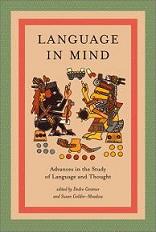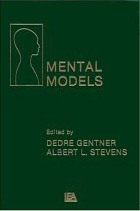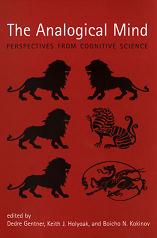Click on the pictures for more information about each book
The
Analogical Mind
Description
Analogy has been the focus of extensive research in cognitive science
over the past two decades. Through analogy, novel situations and
problems can be understood in terms of familiar ones. Indeed, a
case can be made for analogical processing as the very core of cognition.
This is the first book to span the full range of disciplines concerned
with analogy. Its contributors represent cognitive, developmental,
and comparative psychology; neuroscience; artificial intelligence;
linguistics; and philosophy. The book is divided into three parts.
The first part describes computational models of analogy as well
as their relation to computational models of other cognitive processes.
The second part addresses the role of analogy in a wide range of
cognitive tasks, such as forming complex cognitive structures, conveying
emotion, making decisions, and solving problems. The third part
looks at the development of analogy in children and the possible
use of analogy in nonhuman primates.
Contributors Miriam Bassok, Consuelo B. Boronat, Brian Bowdle, Fintan
Costello, Kevin Dunbar, Gilles Fauconnier, Kenneth D. Forbus, Dedre
Gentner, Usha Goswami, Brett Gray, Graeme S. Halford, Douglas Hofstadter,
Keith J. Holyoak, John E. Hummel, Mark T. Keane, Boicho N. Kokinov,
Arthur B. Markman, C. Page Moreau, David L. Oden, Alexander A. Petrov,
Steven Phillips, David Premack, Cameron Shelley, Paul Thagard, Roger
K. R. Thompson, William H. Wilson, Phillip Wolff.
Table of Contents
Preface
Introduction: The Place of Analogy in Cognition
Keith J. Holyoak, Dedre Gentner & Boicho N. Kokinov
I. Computational and Theoretical Approaches
2. Exploring Analogy in the Large
Kenneth D. Forbus
3. Integrating Memory and Reasoning in Analogy-Making: The AMBR
Model
Boicho N. Kokinov & Alexander A. Petrov
4. The STAR-2 Model for Mapping Hierarchically Structured Analogs
William H. Wilson, Graeme S. Halford, Brett Gray &Steven
Phillips
5. Toward an Understanding of Analogy Within a Biological Symbol
System
Keith J. Holyoak & John E. Hummel
II. Arenas of Analogical Thought
6. Metaphor is Like Analogy
Dedre Gentner, Brian Bowdle, Phillip Wolff & Consuelo Boronat
7. Conceptual Blending and Analogy
Gilles Fauconnier
8. Setting Limits on Analogy: Why Conceptual Combination is Not
Structural Alignment
Mark T. Keane & Fintan Costello
9. The Analogical Paradox: Why Analogy is So Easy in Naturalistic
Settings Yet So Difficult in the Psychological Laboratory
Kevin Dunbar
10. Emotional Analogies and Analogical Inference
Paul Thagard & Cameron Shelley
11. Analogy and Analogical Comparison in Choice
Arthur B. Markman & C. Page Moreau
12. Semantic Alignments in Mathematical Word Problems
Miriam Bassok
III. Developmental and Comparative Approaches
13. Analogical Reasoning in Children
Usha Goswami
14. Can an Ape Reason Analogically? Comprehension and Production
of Analogical Problems by Sarah, a Chimpanzee (Pan troglodytes)
David L. Oden, Roger K. R. Thompson & David Premack
Epilogue:
15. Analogy as the Core of Cognition
Douglas R. Hofstadter
Ordering Information
Click here
to order from Amazon.com
Language
in Mind
Description
The idea that the language we speak influences the way we think
has evoked perennial fascination and intense controversy. According
to the strong version of this hypothesis, called the Sapir-Whorf
hypothesis after the American linguists who propounded it in the
1950s, languages vary in their semantic partitioning of the world,
and the structure of one's language influences how one understands
the world. Thus speakers of different languages perceive the world
differently.
Although the last two decades have been marked by extreme skepticism
concerning the possible effects of language on thought, recent theoretical
and methodological advances in cognitive science have given the
question new life. Research in linguistics and linguistic anthropology
has revealed striking differences in cross-linguistic semantic patterns,
and cognitive psychology has developed subtle techniques for studying
how people represent and remember experience. It is now possible
to test predictions about how a given language influences the thinking
of its speakers.
Language in Mind includes contributions from both skeptics and
believers and from a range of fields. It contains work in cognitive
psychology, cognitive development, linguistics, anthropology, and
animal cognition. The topics discussed include space, number, motion,
gender, theory of mind, thematic roles, and the ontological distinction
between objects and substances. The contributors include Melissa
Bowerman, Eve Clark, Jill de Villiers, Peter de Villiers, Giyoo
Hatano, Stan Kuczaj, Barbara Landau, Stephen Levinson, John Lucy,
Barbara Malt, Dan Slobin, Steven Sloman, Elizabeth Spelke, and Michael
Tomasello.
Table of Contents
I. Introduction
1. Whither Whorf
Dedre Gentner and Susan Goldin-Meadow
II. Position Statements
2. Languages and Representations
Eve V. Clark
3. Language and Mind: Let's Get the Issues Straight
Steve Levinson
4. The Key is Social Cognition
Michael Tomasello
III. Language as Lens: Does the Language We Acquire Influence How
We See the World?
5. Sex, Syntax, and Semantics
Lera Boroditsky, Lauren A. Schmidt, and Webb Phillips
6. Speaking vs. Thinking About Objects and Actions
Barabara C. Malt, Steven A. Sloman, and Silvia P. Gennari
7. The Effects of Spatial Lanuage on Spatial Representation:
Setting Some Boundaries
Edward Munnich and Barbara Landau
8. Language and Thought Online: Cognitive Consequences of Linguistic
Relativity
Dan I. Slobin
IV. Language as Tool Kit: Does the Language We Acquire Augment
Our Capacity for Higher Order Representation and Reasoning?
9. Why We're So Smart
Dedre Gentner
10. Does Language Help Animals Think?
Stan Kuczaj and Jennifer L. Hendry
11. What Makes Us Smart? Core Knowledge and Natural Language
Elizabeth Spelke
12. Conceptual and Linguistic Factors in Inductive Projection:
How Do Young Children Recognize Commonalities Between Animals
and Plants?
Kayoko Inagaki and Giyoo Hatano
13. Language For Thought: Coming to Understand False Beliefs
Jill G. de Villiers and Peter A. de Villiers
V. Language as Category Maker: Does the Language We Acquire Influence
Where We Make Our Category Distinctions?
14. Space Under Construction: Language-Specific Spatial Categorization
in First Language Acquisition
Melissa Bowerman and Soonja Choi
15. Reevaluating Linguistic Relativity: Language-Specific Categories
and the Role of Universal Ontological Knowledge in the Construal
of Individuation
Mutsumi Imai and Reiko Mazuka
16. Interaction of Language Type and Referent Type in the Development
of Nonverbal Classification Preferences
John A. Lucy and Suzanne Gaskins
17. Thought Before Language: Do We Think Ergative?
Susan Goldin-Meadow
Ordering Information
Click here
to order from Amazon.com
Mental
Models
Description
This classic volume compiles and describes interdisciplinary research
on the formal nature of human knowledge about the world. Three key
dimensions that characterize mental models research are examined:
the nature of the domain studied, the nature of the theoretical
approach, and the nature of the methodology.
Table of Contents
I. Introduction
Donald A. Norman
II. Phenomenology and the Evolution of Intuition
Andrea A. diSessa
Introduction
Springiness
Ohm's P-Prim
Rolling and Pivoting
A Note on Abstraction
Persistent False Intuitions
Summary and Conclusion
References
III. Surrogates and Mappings: Two Kinds of Conceptual Models for
Interactive Devices
Richard M. Young
Different Kinds of Mental Models
Surrogate Models
Task/Action Mapping Models
Discussion
References
IV. Qualitative Reasoning about Space and Motion
Kenneth D. Forbus
Introduction
Spatial Descriptions
Describing a Particular Motion
Describing Possible Motions
Answering Questions
Discussion
References
V. The Role of Problem Representation in Physics
Jill H. Larkin
Problem Representations
Empirical Studies
Possibilities for Instruction
Summary
References
VI. Flowing Waters or Teeming Crowds: Mental Models of Electricity
Dedre Gentner and Donald R. Gentner
A Structure-Mapping Theory of Analogical Thinking
Two Analogies for Electricity
Electricity and Water -- An Analogy
Experiments on Analogies for Electricity
Experiment 1
Experiment 2
Discussion
References
VII. Human Reasoning About a Simple Physical System
Michael D. Williams, James, D. Hollan, and Albert L. Stevens
Introduction
An Example of the Phenomenology
Defining Mental Model
An Analysis of a Protocol
A Critique
Conclusions
Appendix 1: Questions
References
VIII. Assumptions and Ambiguities in Mechanistic Mental Models
Johan de Kleer and John Seely Brown
Introduction
Qualitative Simulations
Ambiguities, Assumptions and Mechanisms
Implications of the Theory
References
IX. Understanding Micronesian Navigation
Edwin Hutchins
Caroline Island Navigation
Some Anomalous Interpretations
An Alternative Model
Discussion
References
X. Conceptual Entities
James G. Greeno
Analogies Between Domains
Reasoning with General Methods
Computational Efficiency
Planning
Conclusions
References
XI. Using the Method of Fibres in Mecho to Calculate Radii of Gyration
Alan Bundy and Lawrence Byrd
Introduction
Continuous Measure Systems
Choosing Continuous Measure Systems
Uniformity
A Worked Example
Conclusion
References
XII. When Heat and Temperature Were One
Marianne Wiser and Susan Carey
The Experimenters' Enterprise
Source-Recipient Model
Evidence for the Source-Recipient Model
Studies of Artificial Freezing
The Experimenters' Thermal Concepts
Were Heat and Temperature Differentiated?
What Next?
History of Science and the Novice-Expert Shift
References
XIII. Naive Theories of Motion
Michael McCloskey
Misconceptions about Motion
A Naive Theory of Motion
Individual Differences
Historical Parallels: The Medieval Impetus Theory
Naive Theories and Physics Instruction
A Brief Review of Related Research
Concluding Remarks
References
XIV. A Conceptual Model Discussed by Galileo and Used Intuitively
by Physics Students
John Clement
The "Motion Implies a Force" Preconception
Discussion of Similar Arguments in Galileo's Writings
Summary of Characteristics for the "Motion Implies a Force"
Preconception
Post Course Results
Implication for Instruction
Theoretical Implications
References
Appendix 1: Example of a Transcript from the Rocket Problem
Author Index
Subject Index
Ordering Information
Click here
to order from Amazon.com
|



